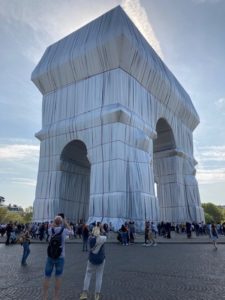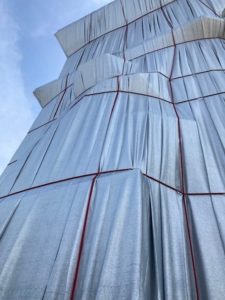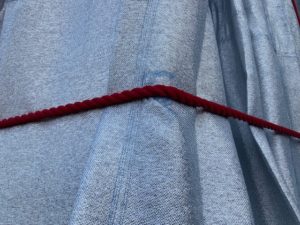I was a shivering, sniffling, nearly 8-year-old boy in February 2005 when we went on a walk through Central Park. I wasn’t sure why we were out freezing in the park when we could’ve stayed in my aunt’s well-heated Upper West Side apartment. I was just about to complain about the cold again when, among the icy greens and browns, flashes of bright, warm color started to appear through the branches in the distance. As we continued walking, I saw these structures, evenly spaced along the path cutting through the park. They were the Gates: 7,503 identical metal archways, each draped with a length of nylon fabric. Everything was fluttering and colored with an orange saffron. My gaze was fixed upward the entire time, and I forgot I was cold. That was the first time that I saw the work of Christo and Jeanne-Claude.
The husband-wife duo Christo Javacheff and Jeanne-Claude Denat de Guillebon were responsible for some of the greatest and most recognizable pieces of site-specific environmental art installations of the twentieth and twenty-first centuries. While projects like the Gates in Central Park or the Surrounded Islands in Biscayne Bay, Florida were iconic, monumental undertakings in their own right, the method that brought the pair a great deal of name recognition was quite literally monumental by nature. Most will probably know the work of Christo and Jeanne-Claude from their wrapping projects, where public buildings and monuments were draped and wrapped in fabric. While the two had been experimenting with that medium since the late 1960s, they didn’t become well-known for it until 1985, when they wrapped a Paris bridge, the Pont Neuf. The installation remained for two weeks and attracted about three million visitors. Because of their public nature, the wrapping projects have become some of Christo and Jeanne-Claude’s best known work. Throughout their career, the subjects of their wrappings have included the Chicago Museum of Contemporary Art, as well as a portion of Little Bay beach in Australia. In 1995, they were given permission to wrap the Reichstag in Berlin. This was their most ambitious project to date, and soon became a symbol of a renewed Berlin and a newly reunified Germany.
Although Jeanne-Claude passed away in 2009, Christo continued in his work right up until his death last May. He completed the Floating Piers at Lake Iseo in northern Italy in 2016, as well as the London Mastaba in London’s Hyde Park in 2018. However, the late artists’ wishes have been respected, and their last project has been carried out posthumously in Paris. The project is being carried out and supervised at the insistence of his nephew Vladimir Yavachev. Starting last week, the Arc de Triomphe was wrapped in a blueish silver fabric and fastened with red ropes, reminiscent of the red, white, and blue of the French tricolor. The wrappings will remain until October 3rd, just in time for the monument to return to its normal state for Armistice Day ceremonies. French President Emmanuel Macron was present at the project’s unveiling, referring to it as “a crazy dream come true”.
Christo first thought of the idea in the early 1960s when he still lived in Paris, but the actual planning did not start until around 2018. The short time between the planning and execution must have been a relief compared to the ridiculous waiting periods that Christo and Jeanne-Claude would normally endure to gain approval to see their work realized. Since many of their works involved well-known public buildings and structures, the duo often had to wait years and sometimes decades before all the right government agencies and conservation committees gave their okay. The duo had to wait about ten years before their Pont Neuf project was approved, while the Wrapped Reichstag took twenty-four years, and the Gates twenty-six years.
Both Parisians and visitors alike have lauded the Arc de Triomphe project, but not all the talk has been kind. It’s understandable, I suppose, to see the project as an eyesore if you’re not used to it. But to see something as solid and heavy as a two-hundred-year-old, enormous limestone monument appear so fluid and dynamic is something that many will probably never see again. Regardless, French journalist Christine Kelly tweeted a photo of the wrapped monument with the short accompanying message: J’ai honte. Désolée (I am ashamed. Sorry). Some have even taken issue with the amount of materials wasted to carry out the project, even though all the fabrics and ropes are made of polypropylene and are therefore recyclable. Florian Philippot, president of the French far-right nationalist party Les Patriotes, probably issued the most caustic criticism. Philippot called the wrapping “a garbage bag draped over one of our most glorious monuments.” While Philippot’s words were harsh, Sebastian Smee of the Washington Post seemed to recognize this insult as providing a deeper meaning to Christo and Jeanne-Claude’s wrapping projects. Smee notes that the Arc de Triomphe was built for a specific purpose, that being to celebrate the military glory of France. While some have interpreted the wrapping method as a symbolic way of preserving the subject of the project, those like Smee seem to interpret the message as trying not to preserve but to cover up; that enormous arches honoring martial triumph are incompatible with our current socio-political climate. The wrappings leave the structure as it is, but it covers up the sculptures glorifying the bellic scenes of the Napoleonic age. So maybe the fabric covering the Arc de Triomphe is actually a garbage bag as Philippot says. As Smee wrote, “Garbage needs to be wrapped.”
By: Nathan Scheer



